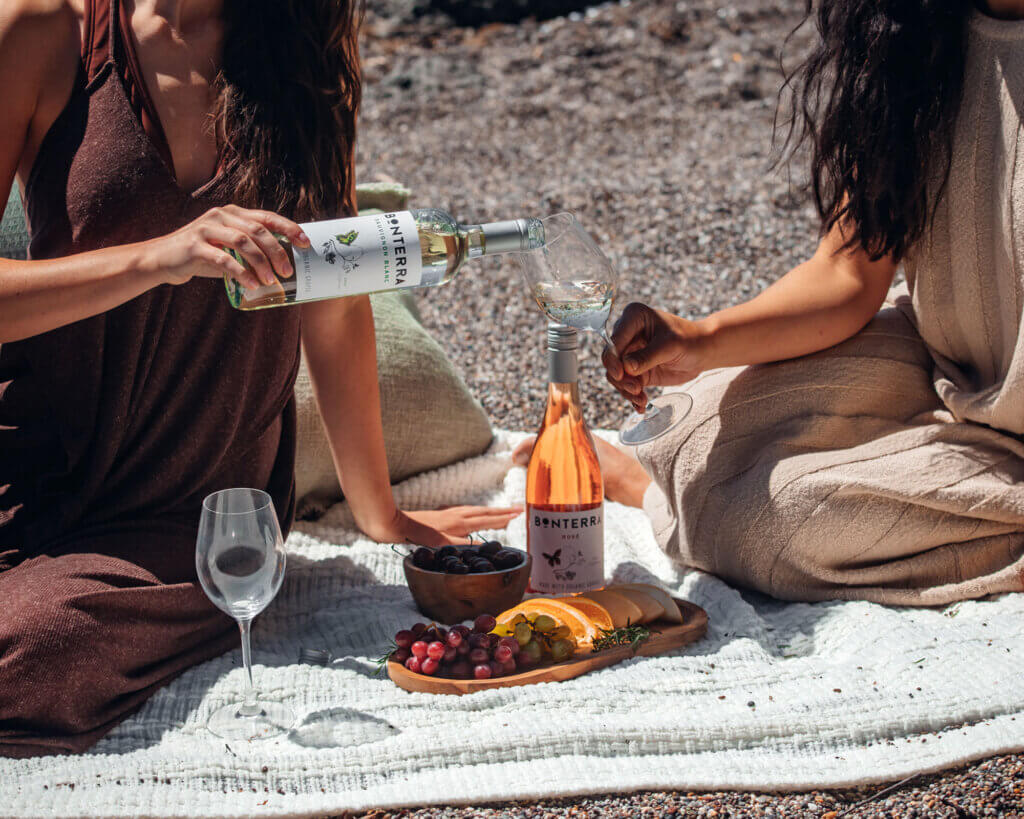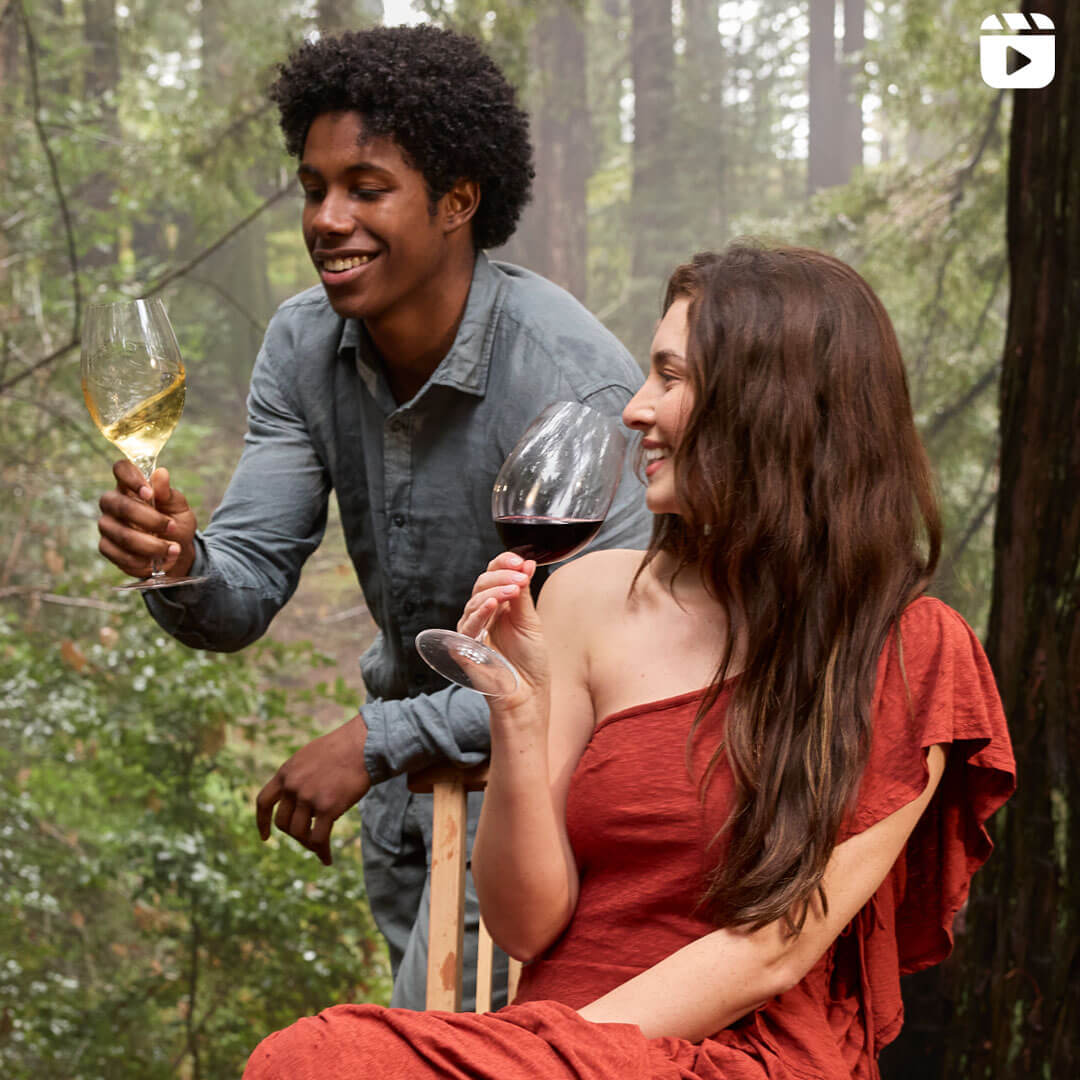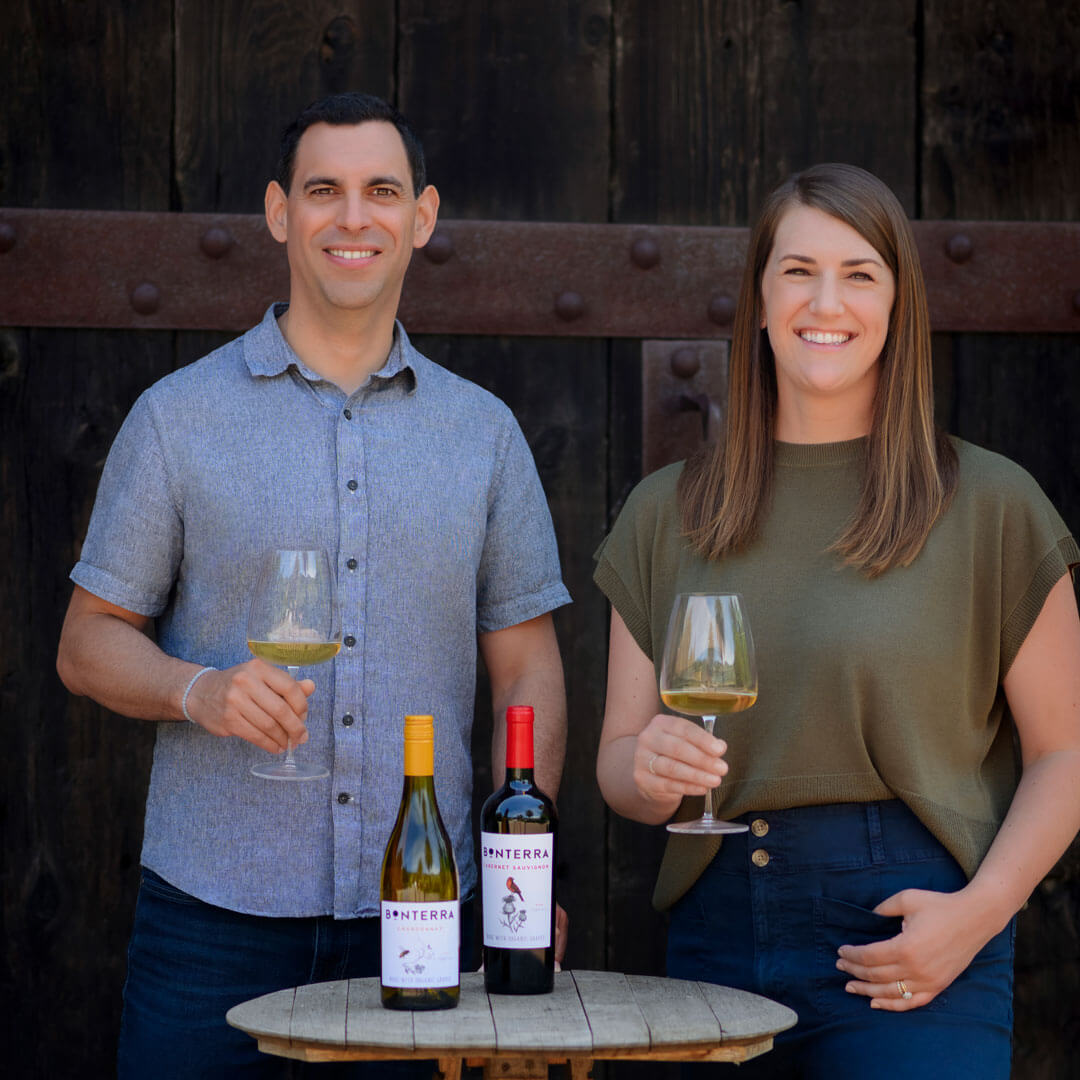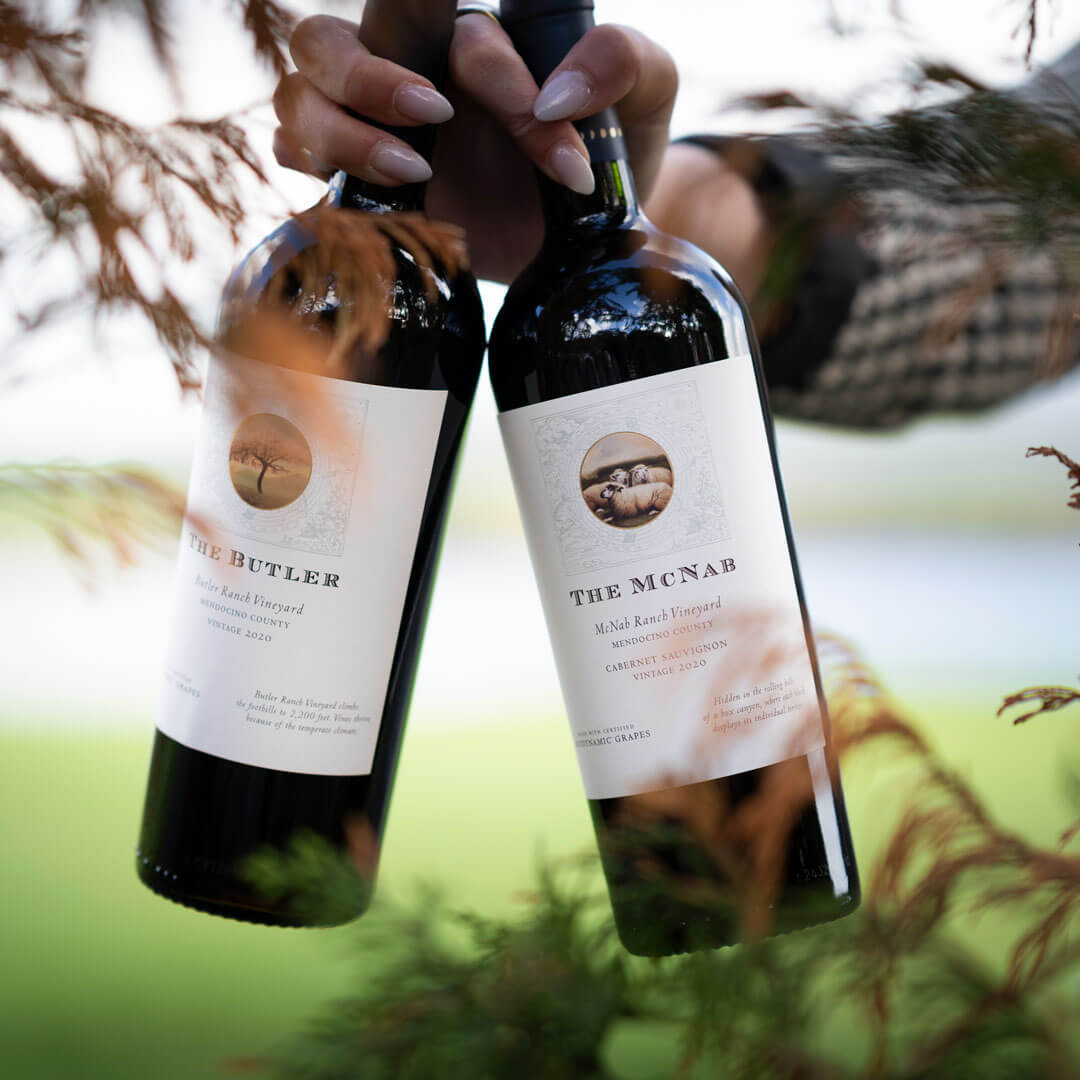Is there any wine pairing the world loves more than a piece of good cheese? In every winemaking culture on earth, cheese holds a prominent place at the table. These two fermented products share a special and timeless affinity, but as you’ve probably already noticed, not all cheeses are equally delicious with all wines.
In this post, we’ll offer a guide to essential pairing principles – texture, richness, acidity, flavor, and intensity – and some specific suggestions for cheeses that partner well with our collections of Bonterra wine.
Basic Principles of Wine and Cheese Pairing
A successful pairing of cheese and wine leaves both participants tasting great. This is sometimes easier said than done, though, since some cheeses have characteristics that will overwhelm or clash with some wines.
If you’re serving European cheeses with European wines, the easiest path to pairing success is to match cheeses and wines from the same region. These cultures have been making and enjoying local cheese and wine so long that they’ve developed synergies in their production. In the Americas, however, these traditions are much younger, and many of the best cheese producing regions don’t produce wine at all.
Fortunately, the usual rules of pairing food with wine apply just as well to cheese, and can help you steer clear of bad matches no matter where your cheese and wine are from.
The first aspect to consider in pairing is texture and richness. Is the cheese light and fluffy, soft and creamy, or hard and crumbly? Lighter soft cheese textures, like fresh chèvre or other young cheeses, tend to be less rich because they contain a lot of air or moisture; these need wines with a similarly light texture. Dense, creamy cheeses do well with dense, creamy wines, and hard aged cheeses shine brightest with structured reds whose tannins can grip and manage that rich, salty intensity. (Blue cheeses are an exception to this, though – which we’ll discuss later.)
Next, think about the acidity in your cheese and wine. In a successful pairing, the wine needs to have at least as much acidity as the food – and with rich, low-acid cheeses like a triple-cream Brie, a high acid wine like Champagne can be exceptionally refreshing.
Flavor and flavor intensity are also critical in pairing cheese with wine. Intensely flavored or salty cheeses can easily overwhelm a wine with delicate nuances. Avoid contrasting flavors. Aim to match like with like – delicate with delicate, bold with bold. Also think about the flavors you’re bringing together, and consider how well they complement one another. For example, the flavor of the molds in blue cheese destroys the sweet fruit flavors in dry wine, making them taste unbalanced, sour and bitter. The best choice for blue cheese is a dessert wine, with the sweetness and concentrated intensity you need to handle blue’s forceful flavors.
Pairing White Wines with Cheese
While many people traditionally associate red wine with cheese, white wines are also versatile partners for a cheese course. Here are some of our favorite cheese pairings for our most popular white wines.
Sauvignon Blanc Pairings
Sauvignon Blanc is typically a light-bodied wine with high acid and moderate-to-high flavor intensity. Our Bonterra Sauvignon Blanc has the delicate texture and the acid needed for tangy, tender young goat cheeses and feta, which can overwhelm other wines. Slightly aged, medium-bodied cheeses like Humboldt Fog and Asiago also pair beautifully with our Estate Sauvignon Blanc, which has a bit more body and heft. The herbal notes in these wines make them particularly wonderful with herb-crusted cheeses, as well.
Chardonnay Pairings
Chardonnay wines generally have lower acidity and intensity than Sauvignon Blanc, with a bit more body – especially if they’ve been aged in oak. While extremely oaky wines are tough to enjoy with cheese (the buttery notes overpower everything else), Chardonnays with a balanced oak influence – like Bonterra Chardonnay and ‘The Roost’ Single Vineyard Chardonnay – offer rich, creamy textures and flavors that pair fabulously with creamy cheeses like Brie (less intense), Munster and Camembert (more intense). The light, toasty notes of these Chardonnays also complement the nutty flavors of Gruyère.
Rosé Pairings
Rosé wines can range quite a bit in acidity and intensity, but they usually offer a light-to-medium body and interesting red fruit flavors like watermelon and strawberry. With moderate acidity and intensity, Bonterra Rosé pairs wonderfully with medium-weight options like sheep’s milk feta, fontina, and slightly aged, herb-crusted cheeses. The wine’s bright fruit intensity complements cheeses with some personality, but won’t overwhelm milder options like mozzarella.
Pairing Red Wines with Cheese
For some people, only red wine with cheese is acceptable. And with some cheeses, only red wines can hold their own! Below are some of our recommended pairings with our core collection of red wines.
Pinot Noir Pairings
Pinot Noir wines are prized among reds for their high acidity, softer textures, and delicate red fruit and earthy aromas. Not surprisingly, they show best with cheeses that mirror their delicacy and silkiness. Brie is always a good choice – its creamy texture and mild, mushroomy flavor complement Bonterra Pinot Noir’s soft tannins and sweet cherry notes. Humboldt Fog, with its earthy vein of ash, and milder Camemberts are also great pairings. The smooth textures, medium richness and nutty aromas of Gruyère and other alpine-style cheeses also love Pinot Noir. You can read our guide on what is a Pinot Noir to learn more about the flavor and aromas. There’s a reason we call this one our ultimate food-pairing wine!
Cabernet Sauvignon Pairings
Cabernet Sauvignon wines like our Single Vineyard ‘The McNab’ Cabernet are intensely flavored, with robust tannins and moderate acidity. Those bold, grippy textures need cheese with plenty of salt and fat to sink their teeth into. The best pairings are typically hard, mature, well-seasoned cheeses like aged Cheddar and Parmigiano-Reggiano, whose intensely concentrated flavors can go toe to toe with the wine’s. Bonterra Cabernet Sauvignon and Estate Cabernet Sauvignon are more moderate in tannin and intensity, so also pair well with cheeses like Gouda and Manchego.
Merlot Pairings
What is a Merlot wine? Merlot wines are appreciated for their plush textures, mild acidity, medium body, and moderate intensity. While Merlot’s flavors are similar to Cabernet Sauvignon, the texture and intensity are somewhere between Pinot Noir and Cabernet Sauvignon. Our Bonterra Merlot’s velvety, rich fruit makes it a great match for similarly smooth, creamy cheeses like Havarti, Asiago, or Ossau-Iraty sheep cheese from the Pyrenees.
Zinfandel Pairings
Zinfandel wines fall somewhere between Merlot and Cabernet Sauvignon, offering great spicy fruit intensity, good acidity, and a medium-to-full body with moderate tannins. That big personality pairs well with intensely flavored, aged cheeses like Dry Monterey Jack, Taleggio, Pecorino, and Parmigiano-Reggiano. While other wines might be overwhelmed, Bonterra Zinfandel has what it takes to stand up to these boldly flavored cheeses.
Pairing Sparkling Wines and Dessert Wines with Cheese
Sparkling wines and dessert wines deserve their own cheese pairing discussion because of their unique attributes.
Sparkling wines, and especially true Champagne, have extraordinarily high acidity as well as refreshing bubbles. Those characteristics make them wonderful palate cleansers – both the acid and the bubbles keep your taste buds lively and awake, even with the richest cheeses. This is why decadent bloomy-rind cheeses like Brie, Brillat-Savarin, Saint-André and double or triple cream cheeses are phenomenal matches with sparkling wine.
Dessert wines like Port, icewine, and Sauternes often taste incredibly sweet on their own, but when paired with blue cheeses like Stilton or Roquefort, they feel just right. The unique flavor of the molds that make a blue cheese blue are the reason why. These flavor compounds tend to diminish our ability to perceive sweetness, which means they wipe out the fruity notes in dry wines, and make dessert wines seem less sweet. Since dessert wines have 7 to 10 times as much sugar as dry wines, they’re well-equipped to take blue cheeses in stride. Port and Stilton is one of the most classic cheese pairings for a reason.
Tips for Hosting a Wine and Cheese Tasting
Now that you know which cheeses are likely to pair the best with your favorite wines, let’s talk about how to put that knowledge to work! If you’re planning on hosting a wine and cheese party, you want to have a good variety on your cheese board. Here are five key tips to make your next wine and cheese party your best one yet.
- Choose a variety of different shapes, milks, and styles. Comparative tastings are way more fun when the options are diverse. Offer some round cheeses as well as some wedges and rectangles. Throw some goat or sheep milk cheese in with the cow, and mix up the textures to keep things interesting.
- Serve your cheeses at room temperature. We can’t fully appreciate their aromas or textures when they’re cold. Take them out of the fridge and unwrap them 45-60 minutes before the party (less in hot weather). You can protect them from prying eyes, pets and too much air with a cover – a bowl turned upside down will work.
- Use a dedicated knife for each cheese. This helps ensure that your guests can easily slice each one, and prevents cross-contamination of flavors. You don’t want pungent bits of blue on your buttery, mellow triple-cream.
- Plan for palate cleansers. Cheeses are pretty salty, intense foods, so it’s important to offer some relief. Sliced baguette is great for wiping your taste buds clean as well as for shuttling cheese to your mouth. If you go the cracker route, choose a type without a lot of salt to avoid overwhelming the cheeses and your guests.
- Taste in order of intensity. It’s generally best to taste milder cheeses first, and work up to the stronger ones. Once our palates have met the blue cheese, it’s hard to taste anything else. Always save blue for last – with a sweet dessert wine!
Enjoying the Pairings with Bonterra
Sharing great wine with a well-chosen cheese is one of life’s great pleasures. While the pairing tips in this post should set you on a promising path, don’t hesitate to follow your own palate when it comes to finding the most delicious matches. One of the common findings in the research that’s been done on cheese and wine pairing is that people are very different – each of us has a unique perspective on whether a pairing works well, or doesn’t.
So, go ahead and you do you! The best cheese and wine pairing is always the one you like the best. Explore our premium white wine variety bundle and premium red wine variety bundle, made with regenerative organic grapes from our estate vineyards in Mendocino County—celebrated as Wine Enthusiast‘s Wine Region of the Year in 2024. These high-scoring white and red wines showcase the exceptional quality and sustainable practices that define our offerings. Discover the perfect match for your favorite cheeses with these meticulously crafted collections.
At Bonterra our organic winery takes pride in our wines. Soft cheeses or hard cheeses, we have wine for sale online for everybody. If you are interested in exclusive offers and releases, check out the wine club.




